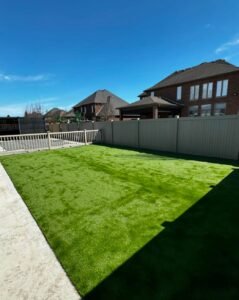In the pursuit of environmentally friendly landscaping solutions, the debate between artificial grass and real grass continues to evolve. While both options have their merits, artificial grass edges natural grass in terms of sustainability, particularly in water conservation and reducing carbon footprint.
This blog further elaborates on this longstanding debate between natural grass and artificial grass.
Natural Grass Vs. Artificial Grass: The Sustainability Edition

Water Conservation
Water scarcity is a growing concern across Canada, with changing climate patterns exacerbating drought conditions in many regions. Real grass lawns require significant amounts of water to stay green and healthy, especially during hot, dry summers. In contrast, artificial grass requires little to no watering once installed. This not only conserves precious water resources but also reduces the strain on municipal water supplies and lowers utility bills for homeowners.
Reduced Carbon Footprint
The environmental impact of lawn maintenance extends beyond water usage to include carbon emissions from mowing, fertilizing, and pesticide application. Gas-powered lawn mowers, in particular, contribute to air pollution and greenhouse gas emissions. By switching to artificial grass, homeowners can significantly reduce their carbon footprint. Synthetic turf requires minimal maintenance, eliminating the need for gas-powered equipment and reducing emissions associated with lawn care activities.
Long-Term Sustainability
Artificial grass offers long-term sustainability benefits that extend beyond water conservation and carbon footprint reduction. High-quality synthetic turf products are made from recycled materials and can last for up to 15 years or more with proper maintenance. This longevity minimizes waste generation and reduces the need for frequent replacements, making artificial grass a cost-effective and eco-friendly choice in the long run.
Biodiversity Preservation
Maintaining a natural grass lawn often involves the use of chemical fertilizers, herbicides, and pesticides to control weeds and pests. These chemicals can have adverse effects on local ecosystems, harming beneficial insects, birds, and wildlife. Artificial grass eliminates the need for chemical inputs, creating a safer and more biodiverse environment for native plants and animals to thrive.
Final Thoughts
Artificial grass emerges as a sustainable choice for eco-conscious Canadians seeking to minimize their environmental impact without sacrificing the beauty of their outdoor spaces. By conserving water, reducing carbon emissions, and preserving biodiversity, synthetic turf offers a practical and environmentally friendly alternative to traditional grass lawns.
Go Green in a Sustainable Way with Turrific Turf’s High-Quality Turf Products
Transform your outdoor space sustainably with Turrific Turf’s high-quality turf products. From backyard design to artificial grass installation in Essex and Windsor, our landscaping company offers eco-friendly solutions for your landscaping needs. Contact us now and go green with us.





